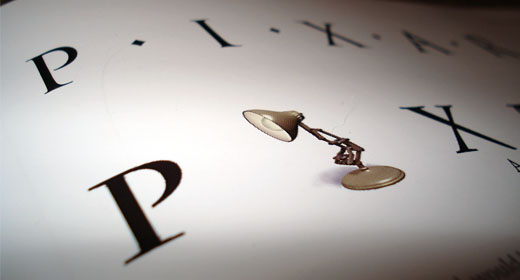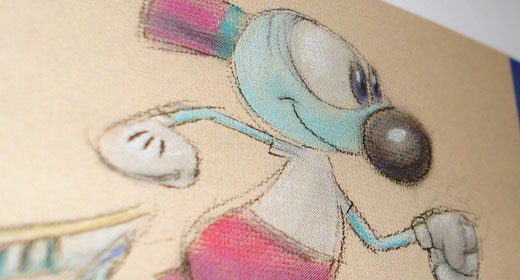Pixar is a company we all know, with most of us having a soft-spot for their films and lively characters. Pixar have proven themselves as maestros of pixels, bringing them together in a way that is best described as symphonic. To Infinity and Beyond! The Story of Pixar Animation Studios, written and pieced together by Karen Paik, is a beautiful and well designed book that very few won’t be able to find some point of interest in. Telling the story of Pixar from their early beginnings through to the merger with Disney, Paik has brought us something hard to put down.

The title is printed on a removable wrap-around.
More than a book about an animation company, To Infinity and Beyond! is about an idea had and a non-stop drive to not only to have it realised, but to realise it over and over without repeat. If you have an interest in Pixar that is only slight, you’ll find something enjoyable in this book. Be it the beautiful artwork and film stills, or the development of technology that goes on, to become standards industry-wide, or perhaps the stories of the process gone through for each film will capture your interest. And if you’re already a big Pixar fan, well, you’ll wet your self.



To Infinity and Beyond! is 300 pages of beauty. Found between the lime-green hard covers are illustrations for each film in a range of mediums, interviews with dozens of people at Pixar—from the founders through to the new(er) generation of directors, writers and tech people—run downs of each of their films, ranging in subject from the genesis of the stories, goals they set for each film, fears had and problems found. And the best (visual) part of all? Pages and pages of beautiful rendered stills from the films.

Illustrated by Jeff Pidgeon (1st) and Bud Luckey (2nd and 3rd).

While it would have been easier to write about nothing more than the major films, author Karen Paik started from before the beginning. The book starts with the stories of the childhoods spent by the three major players of early Pixar—animator John Lasseter, technical genius Ed Catmull and business and money guy, Steve Jobs. We are given small insights into their childhoods and how they ended up on the paths that led to animating feature films. It would seem what they all had in common was an inquisitive nature. Rather than going with convention and saying ‘this is how you animate this’, ‘this is how that works’ they seem to ask the question of ‘this is how it’s done now, but how will it be done later? How can we do it better, in a new, more exciting way?’
Never resting on the laurels of the industry,
their previous films or what they know they can pull-off
A trait kept, amongst other noble ones, such as always hiring people smarter than you, throughout the history of the company. Never resting on the laurels of the industry, their previous films or what they know they can pull-off, it is the constant questioning and refining of processes that has help lead Pixar to being the leader of the pack. Something that is seen from the early days of the careers of the before-mentioned, through to today.

illustrated by Tia W. Kratter using acrylic.


These little two- to four-page micro-chapters give
a nice intermission to the larger ones dedicated to the movies
We are also given behind-the-scene looks at the short films, Pixar’s early years at Industrial Light & Magic (think Star Wars), their shakily-footed affair with the hardware industry as well as a glimpse into the early days of their profitable advertising years. These little two- to four-page micro-chapters give a nice intermission to the larger ones dedicated to the movies, but I often felt that it wasn’t enough. It would have been a real treat to get a much more expanded upon look at the Pixar University—an in-house series of classes set up for anyone to learn new artistic skills—or get a better look at RenderMan, the software which is used in-house and used by many film makers to render and shade special effects (300, Spiderman, Pirates of the Caribbean, Happy Feet and Transformers to name a few). However, it isn’t this kind of content the intended audience is going to be as interested in as they would be the major films. A brief introduction is understandable.



When thinking about the stories told through these pages, that which sticks strongest in the memory isn’t quite what you’d expect. It isn’t the success of what started out as a handful of people in the back-offices of ILM who had an idea, nor is it the repeated success had year after year. No – what striked me the strongest was the failures, mistakes and roadblocks.
…an urging to not have ‘Toy’ in a film’s title
It seemed as if Disney had little to no interest in distributing a 3D animated film, especially one about toys. So at the very beginning things were shaky. Barrages of notes from executives, an urging to not have ‘Toy’ in a film’s title and no particular interest in producing figurines and toys for the film was just the beginning for their first attempt at a feature. We are taken through all of these issues to the point where you truly feel for the small group of creatives who just wanted to try something new. It would have been quite easy to gloss over this part of Pixar’s history, after all, who wants to hear about awful things happening to people you can relate to?

Lou Romano used marker and pencil for this one, one of my favorites.


But we are shown all of the bad as well as the good. To read John Lassetter—the one who directed and wrote the Academy award winning film—say that he was ‘pretty much embarrassed with what was on the screen’ during an early screening of Toy Story is oddly comforting. To see that half way through production, this is how he felt about something he poured his whole self into. These kinds of insights injects some extra humanity into the company, rather than idolising them as creative geniuses who sprinkle out award-winning animation every few years—something I half expected to see. No, we are shown that they, like all of us, go through the creative process, have clients (one another, the audience, Disney) that are the source of a little grief, and that they are passionate about what they do.


What other goal could the author set as their primary, if not to excite? After reading this book, and whilst in the midst of it, it quickly became very difficult to keep quiet about the subject matter. Anyone who would listen would hear me ramble on about the troubles had with Disney, the pastel and watercolour and whatever mediums used for story and character development illustrations or the genesis behind stories. This is why this book is worth buying—why I suggest it and write about it here. If I were to highlight a short-coming of this book, it would be that it almost lacked depth for my tastes. I would honestly relish in an encyclopedic look at the company, their films, employees and everything in between. But alas, I doubt this is going to happen anytime soon. I must say that I started reading this book with a thirst for knowledge relating to Pixar, but I finished the book with an even greater appetite, therefore no amount of detail available publicly is going to satisfy my craving. This isn’t because the content lacked detail, far from it, but because it had just the right amount of it to get me more and more excited. And it’s always a nice compliment to the author and subject when you get to the end of a book and wish it were only the end of the first chapter, isn’t it?

REFERENCES & LINKS
To Infinity and Beyond! on Amazon
If you like the shots you’ve seen, why not go along and show your support for the creators of all this beautiful work and pick up a copy?
Pixar Animation Studios
The homepage for Pixar features some nice images as well as a bit of information. Check out the Artist’s Corner for a bit of fun.
Wikipedia: Pixar
Wikipedia’s entry for Pixar has quite a bit of information. To really get everything out of it that you can, go down to the bars at the bottom and expand the ‘Pixar Animation Studios’ entry.
The Pixar Blog
A neat unofficial Pixar blog.
Pixar Planet
Another great Pixar fan-site to lose some time in.
Copyright
Absolutely all artwork is owned by Disney and Pixar Animation Studios and not by me. Images are being used here for educational purposes only.
Master Your Craft.
Weekly.
Become the designer you want to be.
Join a group of talented, creative, and hungry designers,
all gaining the insight that is helping them make
the best work of their lives.